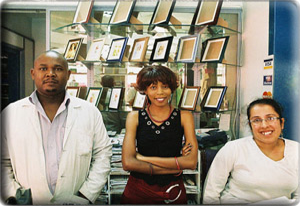without the support and generous help of a lot of people wimbi would never have made it as far as this.
i want to thank everybody for their help, their donations and price reductions, thei patience, late hours and night-shifts as well as their open hearts and ears and the trust in me and my ideas.
i also want to thank all the principals and teachers at the schools i visited (and everybody working there) for their hospitality and advise.
last not least i thank my students for the time and effort they dedicated to project, for crazy and funny ideas an hanging on.
thanks!
p.s: if you want to help, maybe you can translate these pages into dutch. there is a worddocument on the download-page that you might want to use as a starting point.
i want to thank everybody for their help, their donations and price reductions, thei patience, late hours and night-shifts as well as their open hearts and ears and the trust in me and my ideas.
i also want to thank all the principals and teachers at the schools i visited (and everybody working there) for their hospitality and advise.
last not least i thank my students for the time and effort they dedicated to project, for crazy and funny ideas an hanging on.
thanks!
p.s: if you want to help, maybe you can translate these pages into dutch. there is a worddocument on the download-page that you might want to use as a starting point.
special thanks to: phoebe akinyi • brian amuyunzu • andreas • michael atieri • tony ayiera • myriam und felix baele • mbanjwa bandlakazi • ralf beckamp • inge berger • bulelani bobotyana • nonkosi boyle • miss. v.m. budaza (maggie) • neil clayton • mohamed daoud • iain delaney • gerlinde dombrowski • christina gauding • melikoa gonqxoza • thumeka gwita • bettina helfenritter • luke hefson • johannes hossfeld • biko huester • paul hütte • joyce inziani • isaac • mark james • nolusindiso joja • jonathan • jill joubert • mafunda khuthala • alison kingsley-hall • peter kinyanjui • sr. leah • www.loghound.com • matyhintyala lihle • anthony macharia • francis maina • regula manser • nokubonga madyolo • nomuuzo makhonza • luvuyo mandyli • phikelemzi ceasar mashiya • salman matemba • tiny mathe • alice mbenyi • alfred mazaka • samkelele mbebe • lundi mbityana • andile mbobi • john mclaughlin • mendiswa • ntomboyse mgaba • mirella • janele mkhaba • monica • zaza msindise • elvis ndiki • lubabalo ndongeni • molukhanyo ngqeleni • nompumelelo nhebi • ann njambi • joseph njau • thozama nkgayi • thobela nkiwana • nobesuthu • mador nobomuu • falangile nozandine • siyo odwa • pravin patel • carolyn peters • irmingard pinske • gcobani potso • sarat pradhan • barbara reich • annika rudolph • stella rudolph • samuel • wolfgang sandig • stefan schaar • siegfried schmerbeck • andy schmitt :-) • monika schoeller • iris schürch • gabriele shettle • sidumo sibulelo • zoliswa silomo • rachna singh • collin stevens (und errol) • maike stoehr • thandisizwe (ta-charlie) • mbadambdna thando • miss tole • yaso vugokazi • wolfgang weber • hlobo xolelwa • ...













